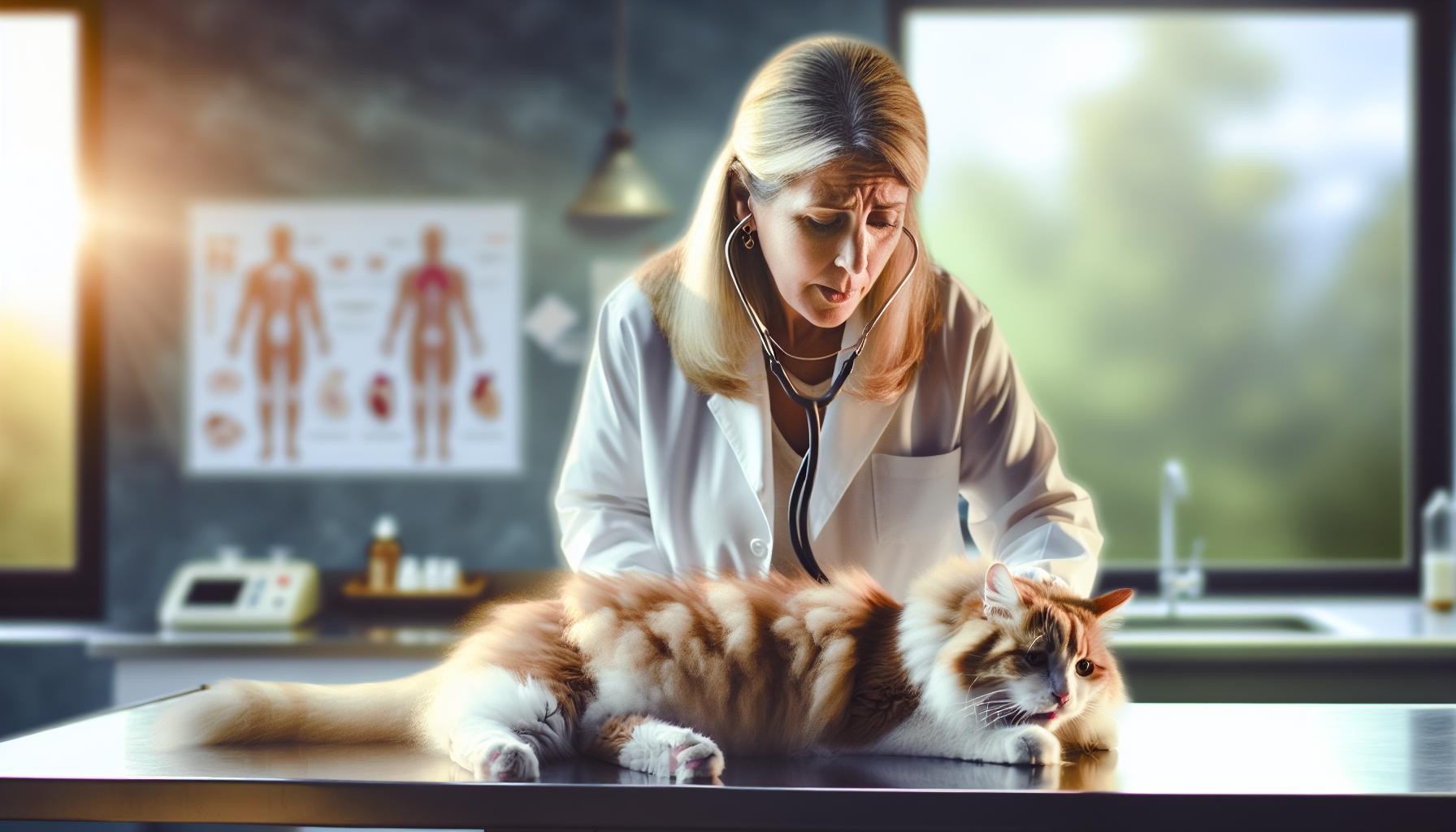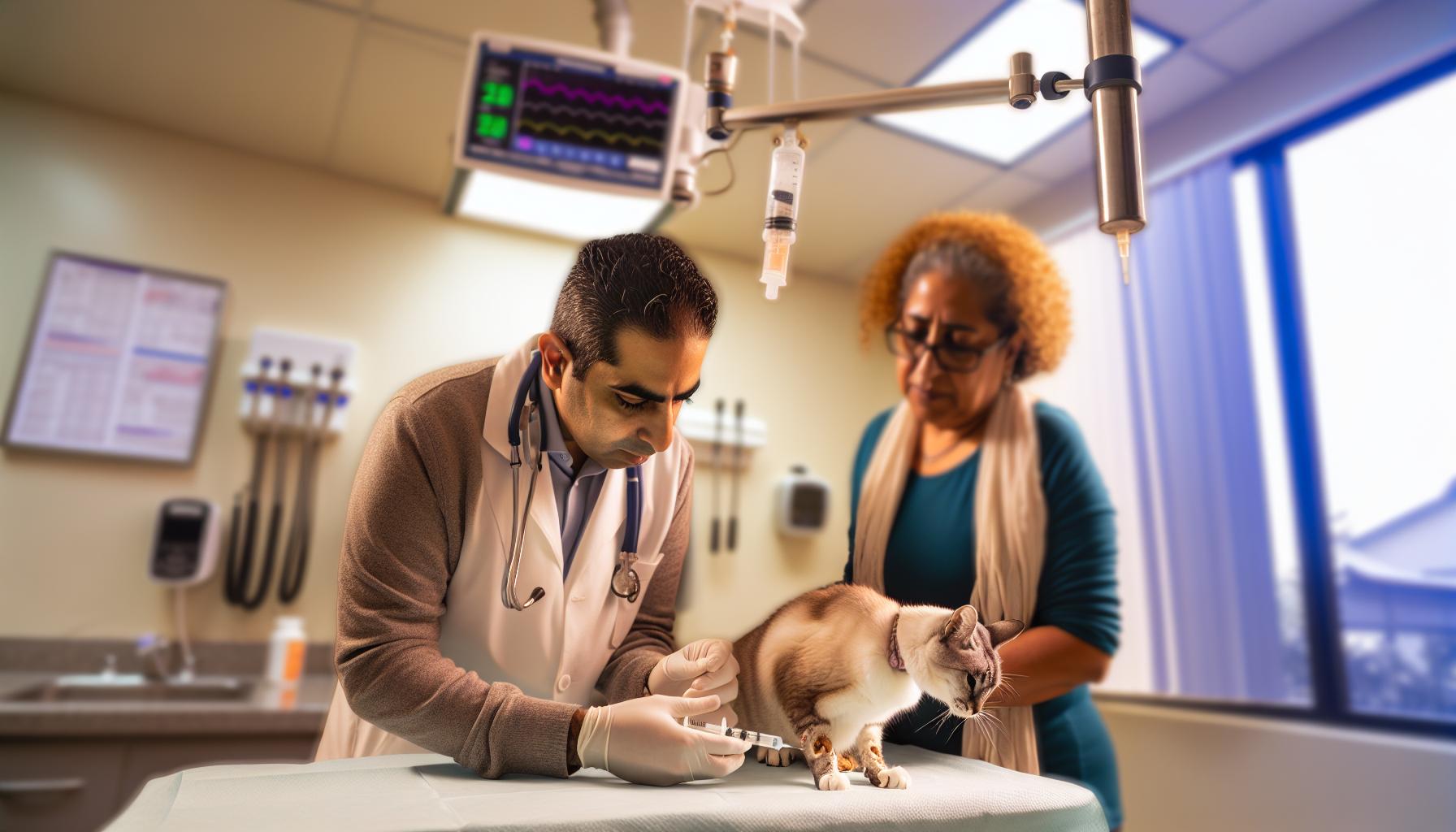Did you know that diabetes is one of the most common endocrine disorders in cats, affecting up to 1.2% of the feline population? When a cat with diabetes experiences vomiting, it can be a sign of serious complications that require immediate attention. As a caring pet owner, understanding the relationship between feline diabetes and vomiting is crucial for your cat’s health and well-being. Navigating these challenges can be overwhelming, but timely medical intervention and informed care can make all the difference in managing your cat’s diabetes effectively. This guide will help you recognize the signs, understand what to look for, and take the proper steps if your diabetic cat experiences vomiting. With the right information, you can empower yourself to make informed health decisions for your furry friend and ensure they lead a happy, healthy life. Keep reading to explore vital insights and practical advice that will enhance your understanding of feline diabetes and support your journey in cat care.
Feline Diabetes: An Overview for Cat Owners
Understanding that your feline companion may have diabetes can be daunting, yet knowledge and proactive management can significantly empower you in their care. Diabetes mellitus, particularly common in cats, disrupts the body’s ability to process glucose effectively, often leading to elevated blood sugar levels. This endocrinopathy is typically manageable with proper veterinary guidance, lifestyle adjustments, and dietary considerations. Recognizing the signs of diabetes early and understanding its potential complications can ensure your cat enjoys a fuller, healthier life.
Many pet owners wonder about the connection between diabetes and specific symptoms or complications, such as vomiting. It’s important to know that while vomiting can occur independently due to various reasons, it can also signal that your cat is experiencing complications from diabetes, such as diabetic ketoacidosis. This serious condition warrants immediate veterinary attention, emphasizing the importance of routine monitoring and recognizing changes in behavior or health.
Daily management of a diabetic cat involves adherence to a structured routine that includes regular feeding schedules, consistent administration of insulin or other medications, and frequent monitoring of blood glucose levels. Proper nutrition plays a pivotal role; it’s crucial to work closely with your veterinarian to design a diet rich in fiber and low in carbohydrates, catering specifically to your cat’s needs. This dietary approach may help maintain stable blood glucose levels and promote overall wellness.
Feeling equipped to manage your cat’s diabetes may involve seeking various supportive resources. Consider sourcing specialized diabetic cat food and products designed to facilitate blood glucose monitoring and insulin administration. Additionally, you may benefit from community support groups or online forums where you can share experiences and tactics with fellow cat owners managing similar challenges. Always prioritize open communication with your veterinarian to tailor an effective care plan that best suits your cat’s unique health profile and needs.
Understanding the Connection Between Diabetes and Vomiting
Understanding the nuances of feline diabetes can be crucial for a cat’s health, especially when it comes to identifying signs of distress such as vomiting. While vomiting in cats can stem from various non-related issues like dietary indiscretion or hairballs, for diabetic cats, it might point toward more serious underlying complications. One significant concern is diabetic ketoacidosis (DKA), a potentially life-threatening condition that arises from untreated high blood glucose levels.
When a cat’s insulin levels are insufficient, it cannot utilize glucose for energy, leading the body to break down fat instead. This process results in the production of ketones, which can accumulate and cause acidosis. If your diabetic cat begins to vomit, it’s essential to consider this relationship. Alongside vomiting, other warning signs may include lethargy, unusual thirst, increased urination, and a sweet or fruity smell on their breath-hallmarks of DKA. If these symptoms are present, immediate veterinary assistance is critical to ensure timely intervention and treatment.
To effectively manage a diabetic cat’s health, regular monitoring and communication with your veterinarian are paramount. Frequent blood glucose checks can help detect fluctuations that may lead to health crises, such as diabetic ketoacidosis. Moreover, adhering to a strict schedule of feeding and insulin administration is vital in stabilizing blood sugar levels. By maintaining a consistent routine and observing your cat for any changes in behavior or health, you will be better equipped to manage their diabetes and potentially avert situations that could lead to vomiting.
Maintaining your cat’s nutritional health also plays a vital role in preventing vomiting and other complications associated with diabetes. Working closely with your veterinarian to develop a proper diet-typically high in protein and fiber while low in carbs-can help stabilize your cat’s blood sugar levels and reduce the likelihood of gastrointestinal upset. Additionally, consider discussing potential anti-nausea medications with your vet if vomiting becomes a persistent issue, ensuring your furry friend remains comfortable and healthy. Always prioritize professional advice and support, helping you navigate the complexities of diabetes management effectively.
Identifying Symptoms of Diabetes in Cats
Many cat owners are astounded to learn that diabetes mellitus is among the most common hormonal disorders in felines, affecting thousands of cats each year. Understanding how to identify the symptoms early can be essential for effective management and improved quality of life for your pet. Recognizing these signs promptly can not only lead to timely intervention but can also prevent complications like diabetic ketoacidosis (DKA), a potentially life-threatening condition.
Cats with diabetes may exhibit a range of symptoms that are important for you to watch for, particularly if your furry friend has a predisposition to this condition. Typical signs include increased thirst (polydipsia), which may lead your cat to drink more water than usual, and increased urination (polyuria), resulting in more frequent trips to the litter box. You might also notice an increase in appetite (polyphagia), despite your cat losing weight-a concerning paradox that often arises due to the body’s inability to utilize glucose effectively.
Another symptom includes lethargy, where your cat may seem less energetic or less interested in play. Additionally, you may observe changes in your cat’s grooming habits, such as unkempt fur, which can be indicative of diabetes. Keep an eye out for a sweet or fruity breath smell; this is a critical sign of possible DKA and warrants immediate veterinary attention. Being vigilant about these symptoms not only helps you address your cat’s health needs but also empowers you to act swiftly, making it easier to manage diabetes and maintain a loving, healthy environment for your pet.
To provide the best care, maintain regular veterinary check-ups, and don’t hesitate to discuss changes in behavior or health with your veterinarian. They can guide you through necessary assessments, including blood glucose monitoring, to ensure your cat receives the tailored care they need. Monitoring your cat’s daily habits can create a valuable dialogue between you and your vet, enhancing your pet’s chances for a successful management plan.
Immediate Actions for Diabetic Cats That Vomit
When a diabetic cat vomits, it can be alarming for any cat owner, as it may indicate underlying health issues that need immediate attention. Vomiting in diabetic cats can be caused by several factors, including fluctuations in blood sugar levels, gastrointestinal problems, or adverse reactions to food or medication. Therefore, it’s essential to act swiftly to manage the situation effectively and safeguard your cat’s health.
First and foremost, stay calm and assess the severity of the vomiting. If your cat has vomited once but appears otherwise healthy-active, drinking water, and not showing signs of distress-monitor them closely for any additional symptoms. However, if vomiting persists (more than once in a short time), is accompanied by severe lethargy, diarrhea, loss of appetite, or any abnormal behavior, it is crucial to seek veterinary assistance immediately. These could be signs of more serious conditions, such as diabetic ketoacidosis (DKA), which requires prompt medical treatment.
In preparing for your visit to the veterinarian, gather important information that may aid in diagnosing your cat’s condition. This includes noting the frequency and appearance of the vomit, recent dietary changes, medication timing, and any related symptoms your cat has shown. Keeping a log of your cat’s eating habits, water intake, and blood glucose levels can also provide valuable insights for your vet.
While waiting for veterinary care, it’s advisable to temporarily withhold food for a few hours to allow your cat’s stomach to settle unless otherwise directed by a veterinarian. You can also encourage hydration by offering fresh water or, if recommended, unflavored electrolyte solutions specifically formulated for pets. Return to feeding your cat with small, easily digestible meals once the vomiting subsides. Gradually introduce their regular food to minimize the risk of further gastrointestinal upset.
Remember, managing a diabetic cat who experiences vomiting requires open communication with your veterinarian. No matter the situation, prioritizing your cat’s well-being through understanding and prompt action ensures that you maintain a loving and healthy environment for them, even during challenging times.
Nutrition Essentials: Best Diet for Diabetic Cats
A well-considered diet is crucial for managing feline diabetes, as nutrition plays a significant role in regulating blood sugar levels and maintaining overall health. Cats with diabetes require a diet that closely mimics their natural eating habits, emphasizing protein while minimizing carbohydrates. Understanding the right food choices can make a substantial difference in your cat’s daily management and long-term health outcomes.
Key Nutritional Components
When selecting food for a diabetic cat, focus on the following components:
- High-Quality Protein: Cats are obligate carnivores, meaning they thrive on protein-rich diets. Look for foods that contain real meat as the first ingredient. Protein helps maintain muscle mass and supports overall health.
- Low Carbohydrates: Carbohydrates can cause spikes in blood sugar levels, so opt for low-carb diets. Many grain-free options are available, providing fewer carbohydrates and more protein.
- Healthy Fats: Incorporating healthy fats can help maintain energy levels without affecting blood sugar. Omega-3 fatty acids found in fish oils can also provide anti-inflammatory benefits.
- Fiber: A bit of fiber can aid in healthy digestion and help regulate blood glucose levels. However, balance is key; too much fiber can lead to gastrointestinal upset.
Practical Considerations
Consulting your veterinarian before making any major dietary changes is essential, as they can help tailor a diet specific to your cat’s needs. Transition to new foods gradually, observing your cat for any adverse reactions such as vomiting or diarrhea, especially after episodes of vomiting. If your cat has shown sensitivity following a stressful event, keep a close eye on food types that may contribute to gastrointestinal issues.
Consider discussing prescription diabetic cat foods, which are specifically formulated to support stable blood sugar levels. Products like Hill’s Prescription Diet m/d and Royal Canin Veterinary Diet Diabetic Formula are designed to ensure optimal nutrition for diabetic cats. Make sure to feed your cat at consistent times each day to help maintain stable blood glucose levels.
For practical shopping, read labels carefully and select products with clearly defined nutritional content. Many reputable brands have specific lines addressing the needs of diabetic pets. Additionally, homemade diets can be an option, but they require careful planning and must be guided by your veterinary team to ensure all nutritional needs are met.
A balanced approach to feline nutrition can transform your cat’s health management journey. By choosing the right diet and working closely with your veterinarian, you’re providing your feline friend with a strong foundation for a healthier, more stable life.
Essential Medical Treatments for Feline Diabetes
Effective management of feline diabetes often hinges on the right medical treatments, which can significantly enhance your cat’s quality of life and longevity. Diabetes mellitus in cats can typically be managed through insulin therapy, which helps regulate blood glucose levels when the body either produces insufficient insulin or does not respond to insulin appropriately. As a cat owner, becoming familiar with essential medical treatments can empower you to make informed decisions that benefit your furry friend.
Insulin Therapy
Insulin is the cornerstone of diabetes management in cats. Most diabetic cats require daily insulin injections, which can be given at home once you’re trained to do so. Your veterinarian will prescribe the type and dosage of insulin that best suits your cat based on their specific needs. Common types of insulin used include glargine and protamine zinc insulin (PZI), both of which are designed to provide a consistent release of insulin, helping to maintain stable glucose levels throughout the day. Regular monitoring is crucial; it may involve periodic blood glucose tests at home or at your vet’s office to ensure the insulin dosage is effective.
Regular Veterinary Check-ups
Ongoing veterinary care is vital for effective diabetes management. Regular check-ups allow your vet to assess your cat’s overall health, monitor for any potential complications, and adjust treatment plans as needed. During these visits, your vet may recommend blood and urine tests to evaluate your cat’s glucose levels and kidney function, ensuring that no additional health issues arise from the diabetes.
Addressing Vomiting and Other Symptoms
If your diabetic cat is experiencing vomiting, it’s imperative to consult your veterinarian immediately. Vomiting can be a symptom of diabetes-related complications, such as ketoacidosis, which is a serious condition requiring prompt medical attention. Such presentations may necessitate emergency treatment, including intravenous fluids and possibly hospitalization.
Supportive Medications
In some cases, your veterinarian may prescribe additional medications to support your cat’s health. For instance, oral medications like glucagon injections may be recommended to manage hypoglycemia (low blood sugar) episodes, while anti-nausea medications can help alleviate vomiting. Always consult your veterinarian before introducing any new medications or supplements to your cat’s treatment plan, as inappropriate use could exacerbate the condition.
With a structured treatment approach that includes insulin therapy, regular vet visits, and appropriate supplementary medications, you can effectively manage your cat’s diabetes. By staying informed and proactive, you can provide the best care possible, ensuring your feline companion leads a happy, active life despite their diagnosis.
Managing Diabetes: Daily Care Tips and Routines
Managing a diabetic cat means committing to a daily routine that promotes your pet’s health and stability. Proper diabetes management not only involves medication but also encompasses a holistic approach that includes diet, monitoring, and emotional support. By creating a structured daily plan, you can help your feline companion lead a happy and healthy life despite their condition.
One of the key components of daily care is maintaining a regular feeding schedule. Cats thrive on consistency, and this is especially true for diabetic cats. Offering meals at the same times each day can help regulate their insulin and blood sugar levels. Choose a high-protein, low-carbohydrate diet specifically designed for diabetic cats, and consult your veterinarian for recommendations. Additionally, you might consider feeding smaller, more frequent meals instead of one or two larger ones, as this can prevent spikes in blood sugar levels.
Monitoring and Care
Daily monitoring of your cat’s health is essential. This can involve checking their blood glucose levels at home using a glucometer, which can help you understand how well their insulin therapy is working. Recording these readings will provide valuable information for veterinary visits and help you notice any patterns that may require attention. Watch for signs of low blood sugar (hypoglycemia) such as lethargy, disorientation, or weakness; knowing these signs allows for prompt action if needed.
Additionally, observe your cat’s attitude, energy levels, appetite, and bathroom habits-a sudden change in any of these areas may indicate a need for veterinary consultation. For example, vomiting, as previously mentioned, can signal serious issues, so being aware of your pet’s typical behavior can aid in early detection of problems.
Emotional Well-being and Environment
Caring for a diabetic cat can be stressful, both for you and your pet. Create a calm environment that reduces anxiety, as stress can affect blood sugar levels. Make sure your cat has a cozy space, access to fresh water, and opportunities for gentle play. Engage with your cat to provide mental stimulation, which can improve their overall mood and health.
Incorporating regular veterinary check-ups into your routine is also crucial. Your vet will not only monitor your cat’s diabetes management but can also provide support and adjustments to the treatment plan as necessary. Consider asking your vet for a referral to a veterinary nutritionist for tailored dietary guidance or a veterinary behaviorist if stress becomes an issue.
By establishing a solid daily routine, you can help ensure that your diabetic cat receives the best care possible. Remember, your proactive measures paired with professional veterinary guidance will empower both you and your furry friend to navigate the challenges of diabetes management effectively.
Monitoring and Tracking Your Cat’s Health
Monitoring your cat’s health is a cornerstone of effective diabetes management, especially when they are susceptible to issues like vomiting. Regular tracking can serve as an early warning system, alerting you to potential complications and ensuring timely interventions. For instance, sudden changes in your cat’s behavior or physical condition could indicate fluctuating blood glucose levels or other medical concerns. By staying vigilant and adopting a systematic approach to monitoring, you can play a pivotal role in your furry friend’s health and well-being.
One of the most valuable tools in your diabetes toolkit is a glucometer. With this device, you can check your cat’s blood glucose levels at home, enabling you to adjust their insulin doses or food intake as necessary. It’s important to establish a routine for testing-many cat owners find success by measuring glucose levels before meals or insulin administration. Recording these readings in a dedicated notebook or digital app can help you identify trends over time, which can be critical information to share with your veterinarian during check-ups. Additionally, be on the lookout for signs of hypoglycemia, such as trembling or weakness. Recognizing these symptoms can prompt immediate action, such as offering a small treat or sugary substance to help stabilize their levels.
Equally important is tracking other indicators of your cat’s health, including their energy levels, appetite, and bathroom habits. Changes in any of these areas could signal a need for consultation with your veterinarian. For example, if your cat exhibits increased thirst or urination alongside vomiting, these could be signs of poor diabetes control or even urinary tract issues, necessitating professional evaluation. Keeping a daily log can help you correlate these observations with blood glucose readings, providing a clearer picture for any veterinary consultations.
Finally, your cat’s emotional well-being plays a crucial role in their overall health. Stress can affect blood sugar levels, so creating a calm and nurturing environment is essential. Engage your cat with gentle play and provide opportunities for mental stimulation. Monitoring their reaction to stressors, whether it’s other pets, loud noises, or changes in the household, is vital. This holistic approach ensures your cat not only receives the necessary medical care but also thrives emotionally, improving their quality of life while managing diabetes. Remember, while you can do much to support your cat’s health, consulting with your veterinarian for tailored advice is irreplaceable.
When to Consult a Veterinary Specialist
Recognizing when your cat needs expert veterinary attention can significantly impact their health and well-being, especially in the context of managing diabetes accompanied by vomiting. It’s crucial to understand that while some vomiting episodes may be minor, frequent or severe vomiting in a diabetic cat can indicate a more serious underlying issue, such as diabetic ketoacidosis or pancreatitis. Being proactive in monitoring your cat’s condition can save not only their life but also distress for both you and your pet.
If your cat experiences vomiting alongside other symptoms like lethargy, reduced appetite, increased thirst, or frequent urination, these could signal a deterioration in their diabetic management. It’s essential to consult a veterinary specialist if vomiting occurs more than once or is prolonged beyond 24 hours. You should also seek immediate veterinary intervention if your cat shows signs of distress, such as excessive vocalization, hiding, or displaying unusual behavior that deviates from their norm.
Additionally, if you notice any changes in your cat’s glucose control, including drastic fluctuations in blood sugar levels-whether they are too high or too low-this is also a critical time to reach out for professional guidance. Your veterinarian may suggest a specialized consultation with an internal medicine specialist who focuses on endocrine diseases in pets for tailored management strategies, including insulin adjustments or evaluations of concurrent health issues.
Lastly, owner awareness of your cat’s unique needs and symptoms is vital. If you’re ever in doubt about your cat’s health or the appropriateness of their diabetes management regimen, err on the side of caution and seek veterinary advice. Building a strong relationship with your veterinary team can ensure that you have reliable support for navigating the complexities of feline diabetes, particularly when unexpected health issues arise.
Helpful Products for Managing Cat Diabetes
Managing feline diabetes can be a challenging journey, but having the right tools and products at your disposal can make a significant difference for both you and your cat. There are a variety of products designed specifically to help cat owners effectively monitor and manage their pet’s diabetes, ensuring they stay healthy and happy.
Blood Glucose Monitoring Devices
Being able to track your cat’s blood sugar levels is essential for effective diabetes management. Consider investing in a reliable glucometer tailored for pets. These devices can be found in veterinary clinics or online, often with special features such as memory storage for multiple readings and alarm settings. Regular monitoring allows you to adjust treatment plans based on your cat’s needs. Additionally, glucose test strips are indispensable, as they work with the glucometer to provide accurate readings.
Specialized Diets
Nutrition plays a critical role in managing diabetes. Many cat food brands offer specialized diets that are lower in carbohydrates and higher in fiber, both of which help control blood sugar levels. Look for foods that have been clinically proven to support diabetic health. Always consult your veterinarian before making any dietary changes to ensure it meets your cat’s specific health requirements.
Insulin Delivery Systems
For cats requiring insulin therapy, it’s crucial to have proper injection supplies. Insulin syringes with fine needles can help manage your cat’s diabetes with ease. Automatic insulin pens are also available, which can simplify the delivery process. Additionally, keeping your insulin refrigerated and frequent temperature checks of the insulin can ensure its effectiveness.
Medical Records and Tracking Tools
Maintaining comprehensive records of your cat’s health is essential for both you and your veterinarian. Use a dedicated app or a simple notebook to track blood glucose levels, insulin doses, food intake, and any symptoms you observe. This documentation can be incredibly helpful during vet visits, facilitating better-informed decisions regarding your cat’s treatment plans.
Investing in these products not only empowers you as a caregiver but also helps create a stable environment for your diabetic cat. As always, stay in close communication with your veterinary team to tailor these aids to your cat’s unique healthcare needs, ensuring their ongoing health and wellbeing.
Supportive Resources for Cat Owners Facing Diabetes
Research indicates that over 50% of felines with diabetes experience frequent vomiting, which can complicate their condition and management. Navigating life with a diabetic cat requires not just awareness but also the right resources to ensure their health and wellbeing. For cat owners facing this challenge, a wealth of supportive materials is available to help foster a deeper understanding of feline diabetes and provide effective management strategies.
Educational Materials
Knowledge is power when it comes to managing diabetes in cats. Numerous websites, books, and forums are dedicated to feline health, offering valuable insights into diabetes care. Resources like the Feline Diabetes Message Board provide a community of pet owners sharing experiences, tips, and advice on managing their cats’ diabetes effectively. Books authored by veterinarians can also provide detailed information on the complexities of feline diabetes, including nutrition, insulin therapy, and the importance of monitoring.
Online Support Groups
Connecting with other cat owners can be incredibly beneficial. Online support groups on platforms such as Facebook or dedicated forums allow pet parents to exchange stories, discuss challenges, and celebrate milestones together. Engaging with these communities can provide emotional support and practical advice on handling the daily ups and downs of managing a diabetic cat, particularly when issues like vomiting arise.
Veterinary Consultation
Your veterinarian is your greatest resource. Regular check-ups and open communication about your cat’s condition can ensure that management strategies are continuously updated to reflect your cat’s needs. Don’t hesitate to consult your vet if your cat experiences changes in behavior, appetite, or if vomiting persists, emphasizing the importance of a thorough medical evaluation. An experienced vet can also provide referrals to veterinary specialists if needed, ensuring comprehensive care.
Useful Products and Tools
Familiarizing yourself with products that can aid in diabetes management is crucial. From specialized pet foods designed for diabetic cats to effective blood glucose monitoring devices, understanding what’s available can make a significant difference. Many online retailers and local pet stores offer a range of diabetic-friendly foods and supplies, so take advantage of these resources. Always consult with your veterinarian before making any changes or purchases to ensure they align with your pet’s healthcare plan.
By utilizing these supportive resources, cat owners can feel more empowered and equipped to manage their beloved pets’ diabetes effectively. You’re not alone in this journey; a wealth of knowledge and community awaits you to help secure a healthier, happier life for your feline companion.
Frequently Asked Questions
Q: What should I do if my diabetic cat is vomiting?
A: If your diabetic cat is vomiting, immediately stop offering food and water, and consult your veterinarian. It’s crucial to monitor their blood sugar levels, as vomiting can indicate serious health issues. Follow the “Immediate Actions for Diabetic Cats That Vomit” section in your care guide for further steps.
Q: Why do diabetic cats vomit frequently?
A: Frequent vomiting in diabetic cats can occur due to several factors, including poorly controlled blood sugar levels, dietary issues, or complications like pancreatitis. Regularly monitoring blood glucose and maintaining a consistent diet can help reduce the risk of vomiting.
Q: Can stress cause vomiting in diabetic cats?
A: Yes, stress can trigger vomiting in diabetic cats by increasing cortisol levels, which may lead to blood sugar fluctuations. Maintain a calm environment and consider stress-reducing strategies to help keep your cat stable.
Q: How can I recognize dehydration in my diabetic cat who is vomiting?
A: Signs of dehydration include dry gums, lethargy, decreased skin elasticity, and reduced urination. If you notice these symptoms along with vomiting, seek veterinary care immediately. Regular monitoring is key to managing your cat’s hydration.
Q: What are the long-term effects of vomiting in diabetic cats?
A: Chronic vomiting can lead to dehydration, electrolyte imbalances, and worsening diabetes control. It may also indicate underlying health conditions. Ongoing monitoring and consultation with your veterinarian are essential to address these risks.
Q: How do I prevent vomiting in my diabetic cat?
A: To prevent vomiting, feed your diabetic cat high-quality, low-carb meals in smaller, more frequent portions to ease digestion. Ensure regular veterinary check-ups and consider any dietary sensitivities your cat may have.
Q: When should I take my vomiting diabetic cat to the vet?
A: Take your cat to the vet if vomiting persists for more than 24 hours, if it’s accompanied by bloody vomit, significant lethargy, or signs of dehydration. Early intervention can prevent more serious complications.
Q: What dietary changes can help manage a diabetic cat that vomits?
A: Switching to a high-fiber, low-carbohydrate diet can aid in managing your diabetic cat’s vomiting. Consult the “Nutrition Essentials: Best Diet for Diabetic Cats” section for specific food recommendations suitable for their condition.
Insights and Conclusions
As we conclude our guide on managing feline diabetes and addressing vomiting, remember that proactive care is crucial. Regular check-ups, mindful food choices, and understanding your cat’s unique needs can make a significant difference in their health journey. If you haven’t already, consider checking out our articles on daily diabetes management and choosing the right diabetic products to further empower your feline care.
Don’t wait until an emergency happens; bookmark our resources or subscribe to our newsletter for timely updates and expert advice. Your cat deserves the best, and we’re here to support you with valuable information every step of the way. Feel free to share your experiences in the comments below or explore more about specialist referrals and lifestyle adaptations that suit your family’s needs. Together, let’s ensure that your beloved companion enjoys a happy, healthy life!












